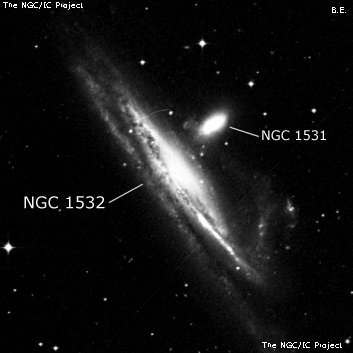
James Dunlop discovered NGC 1532 = D 600 = h2621 on 29 Oct 1826 with his 9" reflector from Parramatta, NSW, and described "an extremely faint ill-defined nebula, rather elongated in the direction of the meridian, gradualy a little brighter towards the centre." Dunlop's position (single observation) is 7' too far east. John Herschel observed this showpiece galaxy on 3 differents sweeps, recording it first on 19 Oct 1835 as "B, vL, vmE, 5' long; A fine and curious object. The following and brighter of two [with NGC 1531]. In the ray is either a vF * or a knot in the nebula."
Joseph Turner sketched the pair on 30 Nov 1875 using the 48-inch Great Melbourne Telescope (unpublished plate II, figure 14) as well as Albert Le Sueur (unpublished plate VII, figure 82). Turner's sketch shows a brighter thin streak along the south edge of the southwest end of the galaxy.
300/350mm - 13.1" (12/22/84): bright, large, pretty edge-on 5:1 SW-NE, very bright nucleus, thin extensions. Forms a close pair with NGC 1531 1.6' NW.
600/800mm - 24" (12/1/16): SN 2016 iae, a type Ic supernova discovered on 7 Nov 2016, was observed 15" E and 52" N of center of NGC 1532, along the western edge of the spiral arm extending NNE. The major axis of the companion NGC 1531 off the west side, pointed exactly to an extremely faint "star". In poor seeing, the supernova was only occasionally visible, perhaps mag 15.5.
900/1200mm - 48" (10/22/11): this showpiece edge-on stretches 7'x1.2', tilting SW-NE. The galaxy is sharply concentrated with a large, elongated, very bright core that is mottled and increases to the center. The surface is knotty, streaky and mottled. A striking dust lane runs along the major axis, slicing the galaxy asymmetrically into two parts to the south of the core. The dust lane expands to a larger, elongated (dark) patch on the NE side of the core. The section to the south of the dust lane is much thinner and brightens to a prominent, very bright knotty 1.5' streak on the SW end [brightest part of a tidal tail extending towards NGC 1531]. A very faint star (B = 18.2) is close to the southwest tip of the bright streak. The fainter strip of galaxy south of the dust lane near the core appears patchy, probably due to dust and star-forming knots. Just northwest of the core is NGC 1531, a bright elliptical that angles perpendicular to the core and forms a striking pair.
IC 2041 lies 7' NE of center, close following the NE tip of NGC 1532. It appeared fairly bright, fairly small, oval 3:2 NW-SE, ~35"x24", small bright core.
Notes by Steve Gottlieb